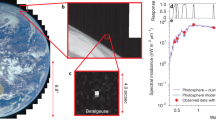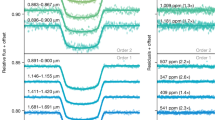Abstract
Previous observations of dark vortices in Neptune’s atmosphere, such as Voyager 2’s Great Dark Spot (1989), have been made in only a few broad-wavelength channels, hampering efforts to determine these vortices’ pressure levels and darkening processes. We analyse spectroscopic observations of a dark spot on Neptune identified by the Hubble Space Telescope as NDS-2018; the spectral observations were made in 2019 by the Multi Unit Spectroscopic Explorer (MUSE) of the Very Large Telescope (Chile). The MUSE medium-resolution 475–933 nm reflection spectra allow us to show that dark spots are caused by darkening at short wavelengths (<700 nm) of a deep ~5 bar aerosol layer, which we suggest is the H2S condensation layer. A deep bright spot, named DBS-2019, is also visible on the edge of NDS-2018, with a spectral signature consistent with a brightening of the same 5 bar layer at longer wavelengths (>700 nm). This bright feature is much deeper than previously studied dark-spot companion clouds and may be connected with the circulation that generates and sustains such spots.
This is a preview of subscription content, access via your institution
Access options
Access Nature and 54 other Nature Portfolio journals
Get Nature+, our best-value online-access subscription
$29.99 / 30 days
cancel any time
Subscribe to this journal
Receive 12 digital issues and online access to articles
$119.00 per year
only $9.92 per issue
Buy this article
- Purchase on Springer Link
- Instant access to full article PDF
Prices may be subject to local taxes which are calculated during checkout



Similar content being viewed by others
Data availability
The raw VLT’s MUSE datasets studied in this paper (under ESO/VLT programme 0104.C-0187) are available from the ESO Portal at https://archive.eso.org/eso/eso_archive_main.html. The reduced raw and deconvolved ‘cubes’ for the observation IDs 6–10 discussed in this paper are available at https://doi.org/10.5281/zenodo.7594682. Data files associated with this analysis are available at https://doi.org/10.5281/zenodo.7620656.
Code availability
The NEMESIS radiative transfer and retrieval code17 used in this study is Open Access and is available for download from GitHub18 or Zenodo20. The deconvolution code described in this paper is Python-based and still under development. However, the current version of this software is available from the corresponding author upon reasonable request.
References
West, R. A., Strobel, D. F. & Tomasko, M. G. Clouds, aerosols, and photochemistry in the Jovian atmosphere. Icarus 65, 161–217 (1986).
Bolton, S. J. et al. Microwave observations reveal the deep extent and structure of Jupiter’s atmospheric vortices. Science 374, 968–972 (2021).
Li, C. et al. The internal structure of vortices on Jupiter as observed by the Juno Microwave Radiometer. In AGU Fall Meeting Abstracts, https://ui.adsabs.harvard.edu/abs/2021AGUFM.P23A..01L (2021).
Smith, B. A. et al. Voyager 2 at Neptune: imaging science results. Science 246, 1422–1449 (1989).
Ingersoll, A.P. et al. in Neptune and Triton. Cruikshank, D. P. (ed.), University of Arizona Press, pp. 613–682 (1995).
Hammel, H. B., Lockwood, G. W., Mills, J. R. & Barnet, C. D. Hubble Space Telescope imaging of Neptune’s cloud structure in 1994. Science 268, 1740–1742 (1995).
Wong, M. H. et al. A new dark vortex on Neptune. Astron. J. 155, 117 (2018).
Hsu, A. I., Wong, M. H. & Simon, A. A. Lifetimes and occurrence rates of dark vortices on Neptune from 25 years of Hubble Space Telescope images. Astron. J. 157, 152 (2019).
Simon, A. A., Wong, M. H. & Hsu, A. I. Formation of a new Great Dark Spot on Neptune in 2018. Geophys. Res. Lett. 46, 3108–3113 (2019).
Wong, M. H. et al. Evolution of a dark vortex on Neptune with transient secondary features. Icarus 387, 115123 (2022).
Wong, M. H. et al. Hubble Space Telescope coverage of the life cycle of Neptune’s dark spot NDS-2018. In AGU Fall Meeting Abstracts, December 2022, id. P23B-05 (2022).
Irwin, P. G. J. et al. Hazy blue worlds: a holistic aerosol model for Uranus and Neptune, including dark spots. J. Geophys. Res.: Planets 127, e2022JE007189 (2022).
Sromovsky, L. A., Fry, P. M., Dowling, T. E., Baines, K. H. & Limaye, S. S. Coordinated 1996 HST and IRTF imaging of Neptune and Triton: III. Neptune’s atmospheric circulation and cloud structure. Icarus 149, 459–488 (2001).
Karkoschka, E. Neptune’s cloud and haze variations 1994–2008 from 500 HST-WFPC2 images. Icarus 215, 759–773 (2011).
Stuik, R. et al. GALACSI – the ground layer adaptive optics system for MUSE. New Astron. Rev. 49, 618–624 (2006).
Sromovsky, L. A., Limaye, S. S. & Fry, P. M. Dynamics of Neptune’s major cloud features. Icarus 105, 110–141 (1993).
Irwin, P. G. J. et al. The NEMESIS planetary atmosphere radiative transfer and retrieval tool. J. Quant. Spectrosc. Ra. 109, 1136–1150 (2008).
Irwin, P. G. J. et al. NEMESIS. GitHub https://github.com/nemesiscode/radtrancode (2022).
Irwin, P. G. J. et al. NEMESIS Documentation GitHub https://github.com/nemesiscode/nemesiscode.github.io (2022).
Irwin, P. G. J. et al. NEMESIS. Zenodo https://doi.org/10.5281/zenodo.5816714 (2022).
Irwin, P. G. J. et al. NEMESIS Documentation. Zenodo https://doi.org/10.5281/zenodo.5816724 (2022).
Carlson, R. W., Baines, K. H., Anderson, M. S., Filacchione, G. & Simon, A. A. Chromophores from photolyzed ammonia reacting with acetylene: application to Jupiter’s Great Red Spot. Icarus 274, 106–115 (2016).
Braude, A. S., Irwin, P. G. J., Orton, G. S. & Fletcher, L. N. Colour and tropospheric cloud structure of Jupiter from MUSE/VLT: retrieving a universal chromophore. Icarus 338, 113589 (2020).
Fletcher, L. N. et al. Mid-infrared mapping of Jupiter’s temperatures, aerosol opacity and chemical distributions with IRTF/TEXES. Icarus 278, 128–161 (2016).
de Pater, I. et al. Jupiter’s ammonia distribution derived from VLA maps at 3-37 GHz. Icarus 322, 168–191 (2019).
Limaye, S. S. & Sromovsky, L. A. Winds of Neptune: Voyager observations of cloud motions. J. Geophys. Res. 96, 18941–18960 (1991).
Martin, S. C., de Pater, I. & Marcus, P. Neptune’s zonal winds from near-IR Keck adaptive optics imaging in August 2001. Astrophys. Space Sci. 337, 65–78 (2012).
de Pater, I. et al. Neptune’s global circulation deduced from multi-wavelength observations. Icarus 237, 211–238 (2014).
Irwin, P. G. J. et al. Multispectral imaging observations of Neptune’s cloud structure with Gemini-North. Icarus 216, 141–158 (2011).
Karkoschka, E. & Tomasko, M. G. Methane absorption coefficients for the jovian planets from laboratory, Huygens, and HST data. Icarus 205, 674–694 (2010).
Högbom, J. A. Aperture synthesis with a non-regular distribution of interferometer baselines. Astron. Astrophys. Sup. 15, 417 (1974).
Steer, D. G., Dewdney, P. E. & Ito, M. R. Enhancements to the deconvolution algorithm ‘CLEAN’. Astron. Astrophys. 137, 159–165 (1984).
Minnaert, M. The reciprocity principle in lunar photometry. Astrophys. J. 93, 403–410 (1941).
Irwin, P. G. J. et al. Latitudinal variation of methane mole fraction above clouds in Neptune’s atmosphere from VLT/MUSE-NFM: limb-darkening reanalysis. Icarus 357, 114277 (2021).
Plass, G. N., Kattawar, G. W. & Catchings, F. E. Matrix operator theory of radiative transfer. 1: Rayleigh scattering. Appl. Optics 12, 314–329 (1973).
Sromovsky, L. A. Accurate and approximate calculations of Raman scattering in the atmosphere of Neptune. Icarus 173, 254–283 (2005).
Starck, J. L., Pantin, E. & Murtagh, F. Deconvolution in astronomy: a review. Publ. Astron. Soc. Pac. 114, 1051–1069 (2002).
Keel, W. C. A simple, photometrically accurate algorithm for deconvolution of optical images. Publ. Astron. Soc. Pac. 103, 723 (1991).
Sezgin, M. & Sankur, B. Survey over image thresholding techniques and quantitative performance evaluation. J. Electron. Imaging 13, 146–165 (2004).
Otsu, N. A threshold selection method from gray-level histograms. IEEE T. Syst. Man Cyb. 9, 62–66 (1979).
Golyandina, N. et al. Multivariate and 2D extensions of singular spectrum analysis with the Rssa package. J. Stat. Softw. 67, 1–78 (2015).
Pearson, K. LIII. On lines and planes of closest fit to systems of points in space. Philos. Mag. Series 1 2, 559–572 (1901).
Sromovsky, L. A. et al. Coordinated 1996 HST and IRTF imaging of Neptune and Triton. I. Observations, navigation, and differential deconvolution. Icarus 149, 416–434 (2001).
Wakker, B. P. & Schwarz, U. J. The multi-resolution CLEAN and its application to the short-spacing problem in interferometry. Astron. Astrophys. 200, 312–322 (1988).
Acknowledgements
The VLT’s MUSE observations were performed at the European Southern Observatory (ESO), under proposal 0104.C-0187. We are grateful to the United Kingdom Science and Technology Facilities Council for funding this research (P.G.J.I.: ST/S000461/1) and also the United Kingdom Space Agency (N.A.T.: ST/R001367/1). S.P.-H. and A.S.-L. have been supported by the Spanish project PID2019-109467GB-I00 (MINECO/FEDER, UE), Elkartek21/87 KK- 2021/00061 and Grupos Gobierno Vasco IT-1742-22. Some of this research (G.S.O.) was carried out at the Jet Propulsion Laboratory, California Institute of Technology, under a contract with the National Aeronautics and Space Administration (80NM0018D0004). L.N.F. and M.T.R. were supported by a European Research Council Consolidator Grant (under the European Union’s Horizon 2020 research and innovation programme, grant agreement No. 723890) at the University of Leicester. I.d.P. and S.L.C. were supported in part by NSF grant AST-1615004 to UC Berkeley. Tracking of the longitude of NDS-2018 and the time variation of DBS-2019 utilized observations made with the NASA/ESA Hubble Space Telescope, which is operated by the Association of Universities for Research in Astronomy, Inc., under NASA contract NAS5-26555. These observations are associated with programmes GO/DD-15502 and GO/DD-16057, which provided support for A.S., M.H.W., G.S.O. and L.S. For the purpose of Open Access, the corresponding author has applied a CC BY public copyright licence to any Author Accepted Manuscript version arising from this submission.
Author information
Authors and Affiliations
Contributions
The observations reported in this paper were obtained under ESO/VLT programme 0104.C-0187, led by P.G.J.I., and including L.N.F., G.S.O., M.T.R., A.S., N.A.T., D.T. and M.H.W. as co-investigators. The initial data reduction and analysis was performed by P.G.J.I. and the subsequent deconvolution was conducted by J.D. Interpretation of the spectral information was assisted by A.J., M.H.W., L.N.F., M.T.R., N.A.T., D.T., G.S.O., S.P.-H., L.S., A.S., I.d.P. and S.L.C., while interpretation of the dynamical implications were assisted by M.H.W., L.N.F., A.S.-L. and R.M.J. All authors contributed to the writing and editing of the paper.
Corresponding author
Ethics declarations
Competing interests
The authors declare no competing interests.
Peer review
Peer review information
Nature Astronomy thanks Naomi Rowe-Gurney and the other, anonymous, reviewer(s) for their contribution to the peer review of this work.
Additional information
Publisher’s note Springer Nature remains neutral with regard to jurisdictional claims in published maps and institutional affiliations.
Supplementary information
Supplementary Information
Supplementary Figures 1–11 and Tables 1–6.
Rights and permissions
Springer Nature or its licensor (e.g. a society or other partner) holds exclusive rights to this article under a publishing agreement with the author(s) or other rightsholder(s); author self-archiving of the accepted manuscript version of this article is solely governed by the terms of such publishing agreement and applicable law.
About this article
Cite this article
Irwin, P.G.J., Dobinson, J., James, A. et al. Spectral determination of the colour and vertical structure of dark spots in Neptune’s atmosphere. Nat Astron 7, 1198–1207 (2023). https://doi.org/10.1038/s41550-023-02047-0
Received:
Accepted:
Published:
Issue Date:
DOI: https://doi.org/10.1038/s41550-023-02047-0
This article is cited by
-
Atmospheric Science Questions for a Uranian Probe
Space Science Reviews (2024)
-
The Uranus Multi-Experiment Radiometer for Haze and Clouds Characterization
Space Science Reviews (2024)
-
Extraordinary Optical Transmission Spectrum Property Analysis of Long-Wavelength Infrared Micro-Nano-Cross-Linked Metamaterial Structure
Plasmonics (2023)
-
Dynamics and clouds in planetary atmospheres from telescopic observations
The Astronomy and Astrophysics Review (2023)



